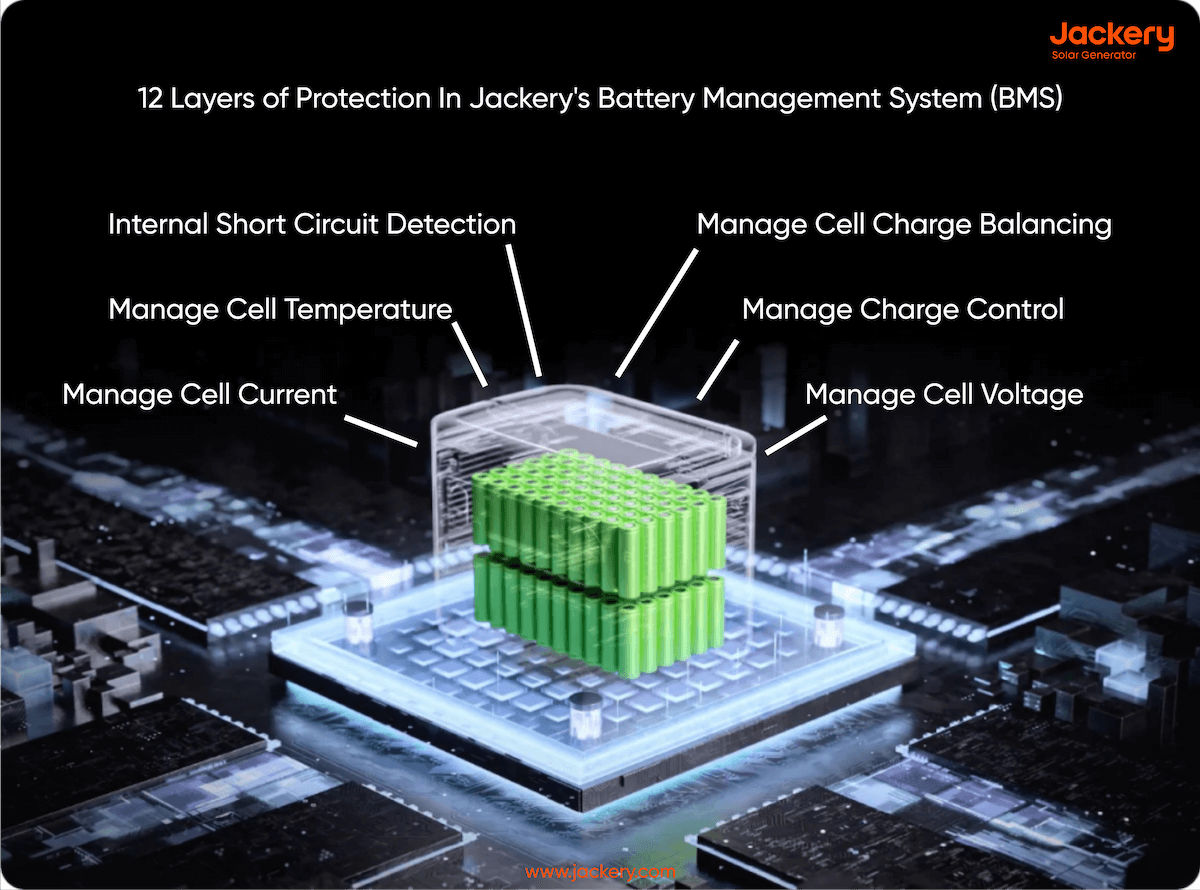Ultimate Guide to Battery Management System
Lithium-ion batteries are becoming popular for solar systems and electric vehicles. Unlike lead-acid batteries, they are lighter, have a longer lifespan, and are more efficient. However, lithium-ion or LiFePO4 batteries are susceptible to damage caused by undercharging, overcharging, and overheating. That's why the advanced battery backups come with a battery management system. It manages the battery performance, including voltage, current, temperature, and more.

Jackery Explorer Portable Power Stations are battery-powered inverter generators featuring various output ports. It uses intelligent BMS and state-of-the-art temperature sensors to improve safety during charging. For example, the Jackery Explorer 3000 Portable Power Station has advanced BMS technology to protect the battery and equipment while charging, ensuring a safe and long serving life.
|
Products |
Image |
Capacity |
Rated / Peak Power |
Battery |
Size |
|
 |
3024Wh |
3000W (6000W Peak) |
NMC |
Length: 18.6 in (47.24 cm) Width: 14.1 in (35.81 cm) Height: 14.7 in (37.36 cm) |
|
 |
2-24 kWh |
3000W (6000W Peak) |
LiFePO4 |
Length: 14.7 in (37.36 cm) Width: 18.6 in (47.3 cm) Height: 14.1 in (35.94 cm) |
|
|
|
2160Wh |
2200W (4400W Peak) |
NMC |
Length: 15.1 in (38.4 cm) Width: 10.5 in (26.9 cm) Height: 12.1 in (30.75 cm) |
|
|
 |
1.25-5 kWh |
2000W (4000W Peak) |
LiFePO4 |
Length: 14 in (35.6 cm) Width: 10.24 in (26 cm) Height: 11.14 in (28.3 cm) |
What Is A Battery Management System?
A battery management system is like the brain of a battery pack. It is a set of electronics monitoring and managing the battery's performance. It is a critical aspect of safe and improved battery operation.
The BMS protects the lithium-ion battery cell from overcharging or over-discharging. In order to maintain the lithium-ion battery, you need to operate it within certain temperature limits. BMS protects the battery by maintaining safety and stability and avoiding temperature sensors.
The industry-leading BMS (Battery Management System) in the Jackery Explorer Portable Power Stations provides 12 layers of protection against short circuits, under and overvoltage, and temperature extremes.
 How Does A Battery Management System Work?
How Does A Battery Management System Work?
The lithium-ion batteries must operate within a specific voltage range. When approaching the high voltage limit, the BMS might request a gradual reduction or complete termination of the charging current to protect the battery from permanent damage.
The battery capacity of lithium-ion diminishes at low temperatures as the chemical reaction rates get slower. A BMS controls the battery pack temperature through heating and cooling by opening and closing various valves, increasing the overall lifespan.

What Are The Benefits of A Battery Management System?
Here are some benefits of investing in solar power systems with a lithium-ion battery management system.
Enhanced Battery Life
One of the main benefits of BMS is the ability to prolong the battery's lifespan. It monitors essential parameters like state of charge, temperature, and state of health. This helps the battery to prevent over-discharging, overcharging, and thermal stress.
Improved Safety
When dealing with batteries and solar systems, safety is of paramount choice. Since batteries are prone to short circuits, thermal runaway, and other hazardous events, BMS provides many critical safety features, such as temperature monitoring, overvoltage protection, and overcurrent protection.
Provides Real-Time Monitoring
With a BMS, you'll get real-time access to all the essential battery data. For example, you can monitor the current, voltage, temperature, and other critical parameters of the battery. This is extremely important when you live off the grid, and the only power source you've is your battery pack.
Improved Efficiency
BMS in a solar system minimizes the losses due to resistance and self-discharge. Monitoring and managing the battery conditions ensures the optimal usage of energy while reducing waste.
What Are The Types of Battery Management Systems?
There are three main battery management system types available, ranging from simple to complex. These types can be differentiated based on topology, which indicates how they are installed and operated.
Centralized BMS Architecture: The batteries are directly connected to the central BMS and tend to be more economical and compact. However, this BMS type needs a lot of ports to establish a connection with all the battery packages.

Modular BMS Topology: In this type, the BMS is divided into many duplicated modules with a dedicated bundle of connections and wires. They are easier to troubleshoot and maintain but are slightly costly.

Primary/Subordinate BMS: In this case, the slaves are restricted to relaying measurement information. As the slaves are simple, their costs are much lower.

Jackery Portable Power Stations with BMS
If you are planning to invest in an off-grid system, it is recommended to have a battery with BMS for safe and efficient battery performance. The fully upgraded BMS protects the battery pack from overcharging and over-discharging. Here are the popular Jackery power stations built with advanced safety mechanisms.
Jackery Explorer 3000 Pro Portable Power Station
The large Jackery Explorer 3000 Pro Portable Power Station has an NMC battery of 3024Wh capacity that can charge 99% of appliances. The safety goes to the next level thanks to the built-in and fully upgraded BMS. The battery management system features 12 forms of protection, an embedded security chip, and 30% enhanced heat dissipation efficiency. Hence, you can safely charge essential home appliances.

|
Product |
|
|
Capacity |
3024Wh |
|
Battery Cell |
NMC |
|
Cycle life |
2000 cycles to 70%+ capacity |
|
Dimension |
Length: 18.6 in (47.24 cm) Width: 14.1 in (35.81 cm) Height: 14.7 in (37.36 cm) |
|
Recharging Methods |
Solar Recharging: 3.5 H (6*Jackery SolarSaga 200W Solar Panels) Wall Recharging: 2.4 H Car Recharging: 35 H |
|
Output Ports |
AC Output (x1): 120V~ 60Hz 25A Max AC Output (x3): 120V~ 60Hz 20A Maximum USB-C Output (x2): 100W Maximum, 5V⎓3A, 9V⎓3A, 12V⎓3A, 15V⎓3A, 20V⎓5A |
|
Working Hours |
Electric Blanket (100W): 25.7H Portable AC (1000W): 2.5H CPAP Machine (60W): 42.8H Electric Grill (900W): 2.8H Coffee Maker (1100W): 2.3H |
Jackery Explorer 2000 Plus Portable Power Station
The Jackery Explorer 2000 Plus Portable Power Station has an expandable LiFePO4 battery with a capacity of 2042.8Wh. It's built using the innovative ChargeShield technology that provides 4 types of physical safety protection, 12 protective algorithms, and 62 protective mechanisms. The unique stepped variable-speed charging algorithm improves safety and enhances the battery lifespan by 50%.

|
Product |
|
|
Capacity |
2-24kWh |
|
Battery Cell |
LiFePO4 |
|
Cycle Life |
2000 cycles to 70%+ capacity |
|
Dimension |
Length: 14.7 in (37.36 cm) Width: 18.6 in (47.3 cm) Height: 14.1 in (35.94 cm) |
|
Recharging Methods |
Solar Recharging: 2 H (6*Jackery SolarSaga 200W Solar Panels) Wall Recharging: 2 H Car Recharging: 26 H |
|
Output Ports |
AC Output (×4): 120V~ 60Hz, 20A Max AC Output (×1):120V~ 60Hz, 25A Max, AC Total Output,3000W Max, 6000W surge peak USB-A Output (x2): Quick Charge 3.0, 18W Maximum USB-C Output (x2): 100W Maximum, (5V, 9V, 12V, 15V, 20V up to 5A) |
|
Working Hours |
Electric Blanket (100W): 17.3H Portable AC (1000W): 1.7H CPAP Machine (60W): 28.9H Electric Grill (900W): 1.9H Coffee Maker (1100W): 1.5H |
Jackery Explorer 2000 Pro Portable Power Station
The Jackery Explorer 2000 Pro Portable Power Station has an NMC battery with a 2160Wh capacity. The advanced and upgraded BMS makes the power station more versatile and reliable. With the help of 9 temperature sensors, the battery backup can determine the peak temperature position according to the stimulation experiments. It also features an independent air duct design to keep the cells and inverters cool.

|
Product |
|
|
Capacity |
2160Wh |
|
Battery Cell |
NMC |
|
Cycle life |
1000 cycles to 80%+ capacity |
|
Dimension |
Length: 15.1 in (38.4 cm) Width: 10.5 in (26.9 cm) Height: 12.1 in (30.75 cm) |
|
Recharging Methods |
Solar Recharging: 5.5 H (6*Jackery SolarSaga 100W Solar Panels) Wall Recharging: 2 H Car Recharging: 24 H |
|
Output Ports |
AC Output (x3): 120V, 60Hz, 2,200W (4,400W Surge Peak) USB-A Output (x2): Quick Charge 3.0, 18W Maximum USB-C Output (x2): 100W Maximum, (5V, 9V, 12V, 15V, 20V up to 5A) |
|
Working Hours |
Electric Blanket (100W): 18.3H Portable AC (1000W): 1.8H CPAP Machine (60W): 30.6H Electric Grill (900W): 2H Coffee Maker (1100W): 1.6H |
Jackery Explorer 1000 Plus Portable Power Station
The Jackery Explorer 1000 Plus Portable Power Station has a LiFePO4 battery that can be expanded from 1.25 kWh to 5 kWh. The innovative ChargeShield technology provides stable power output to protect the equipment from damage. With the help of this battery backup, you can power 99% of appliances efficiently.

|
Product |
|
|
Capacity |
1.25-5kWh |
|
Battery Cell |
LiFePO4 |
|
Cycle life |
4000 cycles to 70%+ capacity |
|
Dimension |
Length: 14 in (35.6 cm) Width: 10.24 in (26 cm) Height: 11.14 in (28.3 cm) |
|
Recharging Methods |
Solar Recharging: 2 H (4*Jackery SolarSaga 200W Solar Panels) Wall Recharging: 1.7 H Car Recharging: 7 H |
|
Output Ports |
AC Output (x3): 120V~60Hz, 2000W (4000W Peak) USB-A Output (x2): 18W Max, 5-5V⎓3A USB-C Output (x2): 100W Maximum, (5V, 9V, 12V, 15V, 20V up to 5A) |
|
Working Hours |
Electric Blanket (100W): 10.7H Portable AC (1000W): 1H CPAP Machine (60W): 17.9H Electric Grill (900W): 1.1H Coffee Maker (1100W): 58 min |
How to Choose A Battery Management System?
You'll need to choose the best lithium-ion battery management system for optimum security, safety, and longevity. Here are a few factors you must consider:
Safety and Protection: The choice of BMS will depend on its safety features, such as short-circuit protection, temperature monitoring, and overcharge protection. For example, Jackery Explorer Portable Power Stations have 12-layer BMS, which makes them highly safe.
Battery Chemistry Compatibility: The different battery chemistries need specific BMS functionalities. You must ensure the BMS is compatible with the battery chemistry, like lead-acid, lithium-ion, and nickel-based batteries.
Balancing Techniques: You must determine the active and passive balancing techniques. Active balancing redistributes charge between the cells and ensures uniform voltage in cells, whereas passive balancing dissipates the excess charge as heat.
If you are looking for a power station or home battery backup with a high level of BMS, Jackery Explorer Portable Power Stations might be worth a try. It comes with 12 layers of protection, making the power station highly reliable and safe.
Battery Management System FAQs
What is inside a battery management system?
A battery management system comprises different functional blocks, such as a fuel gauge monitor, cutoff ETFs, a real-time clock (RTC), a state machine, a cell voltage balance, and a cell voltage monitor.
How does a BMS system work?
The battery management system lithium-ion works by monitoring individual cells in the battery pack. It also calculates the current that can charge and discharge without damaging the battery. The BMS also monitors the remaining battery charge by continuously tracking the energy that enters and exits the battery pack. It uses the data to learn when the battery is drained so you can shut it down.
Do all batteries have a BMS?
No, not all batteries need to have a BMS. However, it is an important feature that makes the battery pack safe. All Jackery Explorer Portable Power Stations with LiFePO4 or NMC lithium batteries come with robust BMS technology. Thus, they are safe and relatively more reliable.
Is it necessary to have a BMS?
Yes. Battery management systems are critical components for protecting the battery health and longevity. Since lithium-ion batteries are highly flammable, BMS helps batteries operate optimally and within the safety limits to avoid fire.
Final Thoughts
Solar generators with battery management systems operate safely and optimally, so you can efficiently power indoor and outdoor appliances. The BMS is the primary battery component that monitors voltage, current, and temperature in the battery cells and increases longevity. Jackery Explorer Portable Power Stations are built with highly advanced 12 layers of BMS protection for safer charging.
For example, the large power-packed Jackery Solar Generator 3000 Pro has an NMC lithium-ion battery with a 3024Wh capacity. It has built-in 12 layers of BMS protection to protect the battery against overvoltage, short circuit, undercharge, and overcharge. If you are looking for small yet powerful battery backups, consider the expandable Jackery Solar Generator 1000 Plus and Jackery Solar Generator 2000 Plus with LiFePO4 batteries.
Disclaimer:
The runtime mentioned for appliances powered by Jackery is for reference only. Actual runtime may vary under different conditions. Please refer to real-world performance for accurate results.





































![[Add - on] Jackery Manual Transfer Switch for Explorer 5000 Plus - Jackery](http://www.jackery.com/cdn/shop/files/add-on-jackery-manual-transfer-switch-for-explorer-5000-plus-9017324.png?v=1754016782&width=170)

























































































How do I get the Battery Savings Mode on my 2000 6kw system?
The above query ( not me!) needs to be extended to say a warning to the phone app at either 15% or 0% depending which battery setting is chosen.
Will my Jackery 1000 v2 tell me via display or phone app when it is reaching zero percent.
Leave a comment